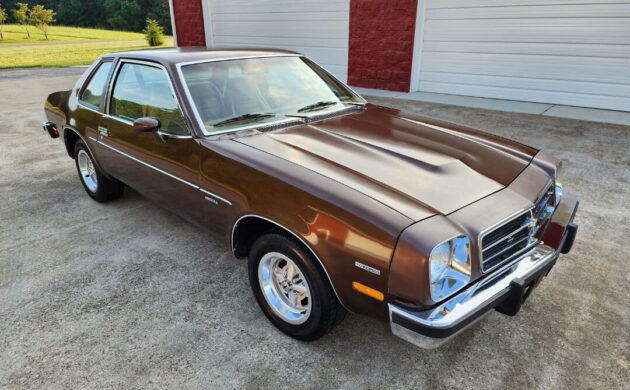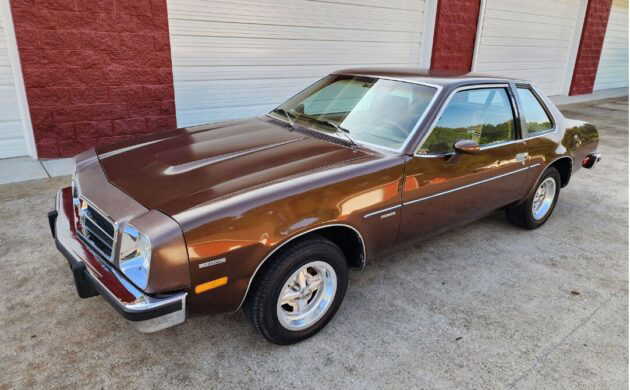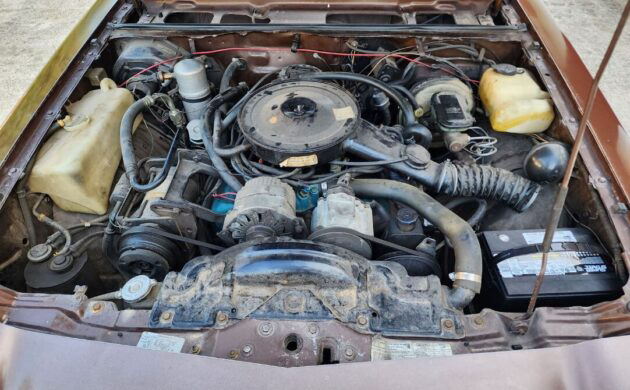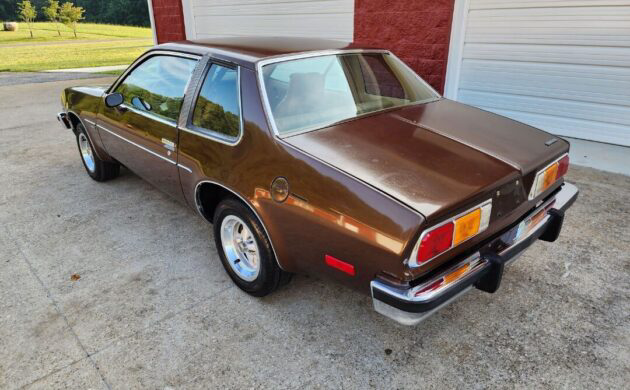Tidy vehicles from the 1970s have developed a strong following because a new generation of enthusiasts views them as an affordable option to enter the world of classic car ownership. Some alternatives seem obvious, but the 1979 Chevrolet Monza is probably less so. However, when the vehicle features a V8 under the hood, they offer performance that stands up strongly against more fancied models. This Monza isn’t perfect, but it is presentable. It has seen little recent action, but returning it to a roadworthy state shouldn’t involve spending much time or money. It needs a new home, with the seller listing it here on eBay in Bowling Green, Kentucky. Bidding sits at $4,049 in a No Reserve auction.
The seller indicates this Monza has spent most of its life in Arizona, with that state’s dry climate resulting in a car that is rock-solid. The panels are clean, and the undercoat has successfully protected the floors from the ravages of tin worm. A previous owner applied a clear coat over its original Dark Brown Metallic paint, but the nose and horizontal surfaces show the deterioration often seen on classics from hot and sunny regions. It is presentable, but refreshing those areas would positively affect the car’s appearance. There are also a few minor marks and bruises, but no issues with this Monza require immediate attention. The winning bidder might decide that a fresh coat of paint would make this classic pop, but that could happen at their leisure. The tinted glass and chrome appear exceptional for a car of this age, and the alloy wheels add a classy air to the vehicle’s appearance.
I expected the Monza’s interior to exhibit the ravages of harsh UV exposure, but this car looks remarkably clean. The dash and pad show no significant issues, and there is only minor wear on the outer front seat edges. The carpet has a few faded spots, and I noticed wear and discoloring on the console lid. However, the interior is easily acceptable for a new owner seeking a driver-grade classic. The original owner ordered the Monza with air conditioning, but this doesn’t blow cold. It isn’t loaded with optional extras, but the driver will welcome the tilt wheel and AM radio.
The range of engines available to 1979 Monza buyers could make your head spin, but this car’s original owner went straight to the top of the class by selecting the 305ci V8. They backed this with a three-speed automatic transmission, adding power assistance for the steering and brakes to provide an effortless driving experience. The 305 produces 130hp and 245 ft/lbs of torque, which are figures that won’t set most pulses racing. However, they were numbers most buyers expected during this period, and while the Monza couldn’t quite match the performance of an auto-equipped Camaro Z28, it kept that iconic model honest. The seller states that although this Monza runs and drives, it has seen little recent use. They suggest it undergoes a thorough inspection before the winning bidder undertakes long journeys, which sounds like wise counsel. They supply this YouTube video of the car running. I can’t spot any issues that might cause the new owner sleepless nights.
Chevrolet produced 163,833 examples of the 1979 Monza across all body styles, with 61,110 buyers selecting the Coupe variant. Many have succumbed to age, abuse, and rust, but this car has survived remarkably well. I admit they aren’t the most desirable classic on the planet, but the fifteen bids submitted so far suggest people like what they see. Would you consider making a play for this Monza, or doesn’t it tick the boxes for you?







This is a GM clone of the Ford Mustang II ! Comparable in every way. I’m more of a Ford guy but would take this given the choice since it’s so much more rare. Just get the exhaust to flow, install an intake with a 600 cfm 4 bbl and enjoy !
I accidentally hit “report comment” instead of reply.
I wanted to say that last pic of the rear quarter view screamed Mustang II! I couldn’t agree more.
I also think this Monza is a pretty sharp little coupe, I’ll bet that interior looked pretty schnazzy in its day.
I’m with you, buddy, but instead of the carburetor, I’d take a hard look at either a bolt on Throttle Body Injection (TBI) system or port injection system. I think that these came from the factory with only a two-barrel carburetor, so you have to bolt on a new manifold for either the four-barrel carburetor or either fuel injection setup, unless you settle for a two-barrel TBI system from Holley. The port injection system comes with a new intake manifold, with the fuel injectors and fuel rails already installed, so it’s a pretty straightforward installation. Other than wiring, you just have to run a fuel return line back to the gas tank.
You’ve got to go to an electric high pressure fuel pump too. I could put a 4 barrel carb on a 350 with much better heads for half the price of converting this 305 to a Holley fuel injection system.
This was built to accept the rotary Wankel engine that never made the cut. GM kept their Camaro as it was. And the Camaro has always been the competitor to the Mustang.
This seems like a nicely preserved example of a car that was rarely preserved at all. I wonder if the inner fenders have holes cut for spark plug access?
I was waiting for the old “I’d hate to change the spark plugs” comments. Todays platinum and iridium plugs easily last 60,000 miles. You would probably be good with one set in your lifetime on a hobby car.
They’d last even longer with an upgrade to electronic ignition and electronic fuel injection. I don’t remember when GM switched over from conventional breaker points to the High Energy Ignition (HEI) setup, with the ignition coil in the distributor cap, and I can’t see the distributor in the pictures.
I was more concerned about the car being defiled in a way that’s difficult to repair than I was about changing the spark plugs.
You could always just pull the engine!
Todays platinum and iridium spark plugs easily last 60,000 miles. Very doubtful that you would change them more than once in your lifetime on a hobby car.
Re the ignition system, there’s a GM HEI ignition hiding in plain sight on the far side of that air cleaner,…
Had one of these with a warmed over 350 and it was not bad for what it was: wouldn’t pay the opening bid though for this just because it has a 305, not to mention the Unmentioned damage that occured which rerquired the replacement of the front end clip,…..
Are you sure that the front end was hit? The early paint additives for plastic body parts, like the grille surround in this example, weren’t that great, and plastic painted parts often faded or peeled before the adjacent steel panels, due to a combination of UV exposure and the bonding agent in the paint not doing its job. A friend’s father bought a brand new 1975 Cadillac Eldorado, and within a year, the paint was peeling off of the plastic parts that covered the gap between the bumper and the fenders. The dealer tried to fix it, but they were unsuccessful. To say my friend’s father was unhappy is an understatement! The family traded their cars every two (2) years anyway, and the father’s next car was a Seville.
You’re thinking of the GTO “Judge’ which had the problem you’re describing with it’s poly front end clip: that was a common issue with the flexible nose that they had. This 1979 is a decade later though and GM was already on to better paint formulas by then. If it was me I’d be suspicious of this car without any documentation showing its history, especially so since the that front end clip looks soo bad in comparrison to the rest of the paint on the car: anything doing that much harm to the finish on the clip is bound to be strong enough to affect the rest of the paint on the car in some way but the rest of the paint looks too perfect for something this age.
Now that I think about the first few years of the 2nd gen Firebirds had that issue as well, which always ticked me off: the pre five mph bumper 2nd gens were The best looking years of that body style and I always thought that one with a healthy BB Chevy would have been the perfect car.
My parents, bought new, a 76 Olds Starfire GT, stablemate to the Monza, which I inherited, probably about 1980. Can affirm the paint fading differently on the plastics. It looked like they had been replaced.
Unfortunately you’re jumping to the conclusion that what happened in your case applies to the rest of the country. If what you said was true about the paint tech not being up to the task at that time then it would apply to pretty much any manufacturer that had poly componants in their front end. And Chrysler at least used a lot of it in smaller front end clip panels(usually around the bumper) in it’s downsized Gran Furys and Aspens and Volares: they hardly ever suffered from the issues that you’re describing even when the vehicles were environments like for example Ontario, where they flood the roads with soo much salt in the winter that the steel panels literally rot off the car. And you’d see pretty much the same thing in the rust belt further south, where the winter weather is a little bit more begnin.
Found it! I zoomed in on the picture and I could just make out the HEI distributor cap! Sneaky little devil!
Looking at the pictures under the hood and of the underside, my semi-educated guess is that I don’t think there was any damage to the car. My guess is that, GM paint and plastics being what they were, it faded differently and the clear coat did not take.
It took all of the paint companies time to make their clear coats work well. The early clear coats had a nasty habit of peeling off of the car in spots, making the car look like it has some kind of skin rash, as the color coat oxidized where the clear coat had peeled. My brother’s 1993 Mustang Cobra had this problem, the red paint all mottled and faded where the clear coat was peeling in silver dollar sized spots all over the car! I don’t think that the paint companies finally got it right until after the turn of the 21st Century.
General Motors got rid of points after 1974, All models had the High Energy Ignition starting in 1975 (optional in 1974 on Cadillac).
Ahhh my grand mother had one of these black with black interior. Was a cool car. Granny had the hot rods. 1972 Monte carlo with a 402 engine. 1968 and a 1971 fire bird cool cars
I knew a girl who had a Monza fastback with a 305 and a 4-speed. I don’t know if the drivetrain was original or swapped in. My main memory of that car was how much the engine shook and vibrated the whole car, which makes me think was swapped.
Looking at this car reminds me of the 79 Sunbird me and the ex-wife had. Same color interior but with a dark green exterior. We took it down to Tennessee in the summer and blew a head gasket on the Iron Duke. Her dad had to come down and drive us back.
Did these really make so much torque that they required that support running from the trans to the rear end?
There might have been a different way to do it, but third gen (1982 +) Camaros also had that torque arm rear suspension, also with a 305 automatic. And it’s pretty flimsy.
it’s a rear end locator along with the panhard rod..
My first used car I bought after college. Mine was a 1980 notch back (town coupe), silver with red interior. I had the iron duke 4 cyl., auto, aluminum slot wheels. I kept it tuned and serviced. I street raced several 6 cylinder cars and kept up with them or beat them (wide wheels and tires on the back meant great looks and minimal wheel spin). Had a friend with a v8 such as this one. He dropped a warmed up 350 in it. It fit, but same as the 305, hard to change plugs. His car performed well and was a terror on the streets. after a while he had the body flex and twist issue so bad that the doors would pop open under hard acceleration. Something to be said for frame ties on a unibody car. I bought my car with 50,000 miles on it for $1500. I put another 100,000 miles on it and sold it for $1000. Not a bad deal.
Oh, by the way…my brother bought a new Monza Spyder hatchback with the v8. he somehow got headers on it and made the parents mad every Sunday morning he came home after church started and back then the church didnt have AC so the windows were open. The church was on a pretty good hill and when he was coming home, had to hit the gas to get up the hill. Ahh, memories…haha
Ever tried to change the spark plugs in one of these? LOL
I put headers on the 262 in mine. Tight.
It does not look like a clone of the Mustang 2 but to me it looks like a clone of an American Motors product. Especially the interior.
Many moons ago i had one , if i were to have another one , it would need a engine change to an LS , a transmission change , a differential change , real 4 wheel disc brakes , cooling and all ! I cannot stomach the interior or exterior color so , its not going to happen cause i don’t really want to live in the past and the new cars are soo much better …
I had one in my 20s moved from Indiana to Silicon Valley to work in the Semiconductor Industry. That car was a Sleeper. I used to race Corvettes on my way to work in the morning down Central Expressway from mountain view to Santa Clara. A little screamer. So fun at the time.
I agree, the notchback looked like a Mustang II clone, but the styling of the hatchback was much better. Except for what had to be done to shoehorn the V8 (262, 283, 305) into these, they were actually nice little cars, especially with a Buick V6 in them, that could be turbocharged! The Wankel, while it might have been a hoot to drive, was effectively killed by the twin bogeys of fuel economy and emissions. It was a thirsty little bugger, and that wouldn’t do during an oil crisis! The emissions issues were also problematic, and getting the Wankel to pass the ever tighter emissions rules was becoming too expensive, so goodbye Wankel, hello, small block V8, complete with the hidden spark plugs, LOL!